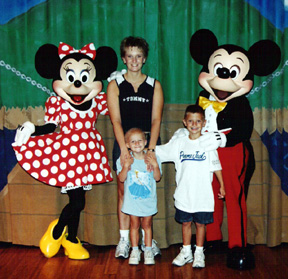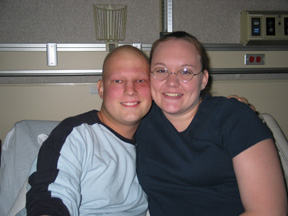 |
Carrie Lamm with her children, Abby, left, and Tyler at Disney World during a Make-A-Wish vacation. Abby was diagnosed with rhabdomyosarcoma in 2002. |
Then, her 3 -year-old daughter was diagnosed with it.
When a tumor was found in Abby Lamm’s left calf muscle in 2002, the Cherokee, Iowa, family sought help from physicians and researchers at UNMC.
James Neff, M.D., UNMC orthopedic oncologic surgeon, removed the tumor, but credits the work of other UNMC experts, including Julia Bridge, M.D., who performed chromosomal assessment on the tumor, for helping save Abby’s leg from amputation. It was their work, he said, that helped the cancer team decide the appropriate treatment.
Lamm said her daughter, with the exception of not being able to skip like her friends, is a healthy, developing 4 1/2 year old. “Dr. Neff and everyone here was so very thorough and good with her. I felt very comfortable at UNMC and was glad we came here,” she said.
As patients and families struggle to recover from cancer, countless people are working behind the scenes to advance treatment through research to save and improve the lives of those with cancer.
 |
Josh Amen of Omaha was diagnosed with rhabdomyosarcoma in January. Amen, 22, has undergone chemotherapy and radiation for the cancer, which was found in his sinuses, rib and pelvis area. Amen got married last weekend and is looking forward to his honeymoon – something he and his wife, Melissa, will take after his course of treatment. |
Dr. Maurer, a pediatric oncologist and rhabdomyosarcoma expert, has a longtime link with the national Children’s Oncology Group. Last year he received a Lifetime Achievement Award for his significant contributions to pediatric cancer research, specifically his work with the Intergroup Rhabdomyosarcoma Study Group (IRSG), which he helped form in 1972.
Dr. Maurer chaired the IRSG for 25 years, becoming one of the world’s foremost experts on the disease. The group is credited with raising the cure rate of children afflicted with the disease from 20 percent to 75 percent. Rhabdomyosarcoma, the most common of soft tissue sarcoma, develops in voluntary muscles and is most often found in the head, neck genitourinarary tract and extremities.
“The world’s leading experts on childhood soft tissue sarcoma are coming to UNMC to present and discuss their latest results on various aspects of these highly malignant cancers,” Dr. Maurer said. “Bringing the entire scientific field to this level of cutting-edge knowledge at one time is rare and will advance the exploration of exciting new ideas and cooperative science relationships.”
Conference attendees will include oncologists and researchers from France, Italy, Germany, Spain, the United Kingdom, the Netherlands, and the United States. They will represent the Children’s Oncology Group (North America), the International Society of Paediatric Oncology, the Italian Cooperative Soft Tissue Sarcoma Group, and the German Collaborative Soft Tissue Sarcoma Group.
Attendees will hear presentations on rhabdomyosarcoma and other soft tissue sarcomas in children given by researchers from the United States, Canada and Europe.
“The summit is an opportunity for researchers throughout the world, with an interest in pediatric sarcomas, to exchange ideas and begin discussions regarding future possible international collaborations,” said James Anderson, Ph.D., Stokes-Shackleford Professor of Biostatistics and chair for the UNMC Department of Societal Medicine, who helped coordinate the conference. “We are honored to host this conference.”
Drs. Anderson and Bridge will make presentations during the conference. Dr. Anderson will discuss factors found in analysis of Children’s Oncology Group studies used for planning of current and proposed studies, as well as present a co-talk on prognostic factors for metastatic rhabdomyosarcoma. Dr. Bridge, a UNMC pathologist and cytogeneticist, will talk about the pathologic evaluation and classification of non-rhabdomyosarcoma soft tissue sarcomas.
Dr. Bridge said meetings like this are important because scientists and health professionals always learn new information about the biological event of tumors, which helps develop new treatment strategies. She serves on the Children’s Oncology Group’s Patho/Biology committee for soft tissue sarcomas.
“Our job is to define what causes the cancer to begin with,” Dr. Bridge said. “The more we know, the better we are equipped to develop new therapies.”